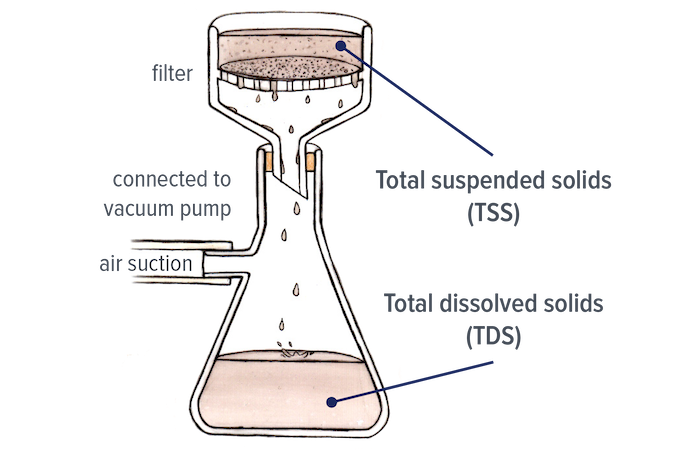What is it?
TSS and TDS measure the amount of particulate matter (tiny pieces of things) floating in water. In lakes and rivers this can include particles from algae, other organic matter, silt and clay, and other inorganic substances (such as minerals, salts and metals).
These particles, or ‘solids’, can be divided into two types by passing the water through a filter. The particles that are large enough to be held back by the filter are called total suspended solids (TSS), while the particles that pass through the filter are called total dissolved solids (TDS).

Why does it matter?
Total suspended solids (TSS) values are often related to the turbidity (cloudiness) of water. If TSS is high and the water is murky then light from the sun will not travel well through the water, making it difficult for plants and algae to grow.
This, in turn, can reduce productivity (the amount of plant and animal life that a river or lake can support) and oxygen generation. Lots of soil and silt in the water can also clog fish gills and, if it settles to the bottom, bury fish eggs.
Total dissolved solids (TDS) include dissolved minerals and salts in the water. As a result, TDS is often closely related to conductivity, salinity, alkalinity, and hardness measures. Most freshwater fish and bugs cannot tolerate high TDS because they are not adapted to saline (salty) water, like marine fish are.

How is it measured?
TDS and TSS are usually measured from a water sample in the lab, because it is necessary to filter the sample. The size of the particles that don’t pass through the filter (and are therefore considered to be TSS) depends on the specific filter used but may range in size between about 0.5 to 2 micrometres (µm). Measures of TDS and TSS are reported as a concentration (e.g., mg/L).
Related to TSS: turbidity, chlorophyll, water clarity (e.g. Secchi depth, water colour).
Related to TDS: conductivity, salinity, alkalinity and hardness, metals concentrations.